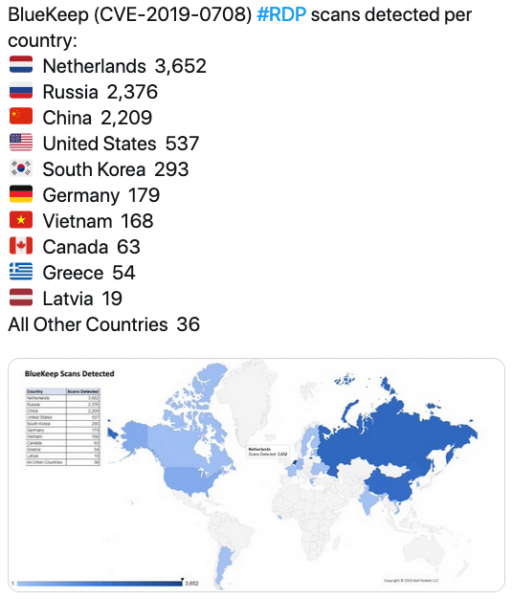Nearly one million devices are vulnerable to attacks involving the Windows vulnerability dubbed BlueKeep and it appears that hackers have already started scanning the web in search of potential targets.
The vulnerability, tracked as CVE-2019-0708, impacts the Windows Remote Desktop Services (RDS) and it was addressed by Microsoft with its May 2019 Patch Tuesday updates. The flaw has been described as wormable and it can be leveraged by malware to spread similar to the way the notorious WannaCry ransomware did back in 2017 through the EternalBlue exploit.
An unauthenticated attacker can use the flaw to execute arbitrary code and take control of a machine without any user interaction by sending specially crafted requests via the Remote Desktop Protocol (RDP).
Microsoft has released patches for Windows 7, Server 2008, XP and Server 2003. Windows 7 and Server 2008 users can prevent unauthenticated attacks by enabling Network Level Authentication (NLA), and the threat can also be mitigated by blocking TCP port 3389.
Many expect to see attacks involving BlueKeep at any moment as several proof-of-concept (PoC) exploits have already been developed — although, none of the PoC exploits has been made public. Industrial and medical products are also at risk.
Errata Security’s Robert Graham has conducted an internet scan using the masscan port scanner and a modified version of rdpscan and found more than 923,000 devices that appear to be vulnerable to BlueKeep attacks.
“Hackers are likely to figure out a robust exploit in the next month or two and cause havoc with these machines,” Graham said in a blog post.
The expert has also identified over 1.4 million machines that appear to have been patched and roughly 1.2 million that cannot be exploited from the internet due to the use of NLA or the Credential Security Support Provider protocol (CredSSP).
At least two cybersecurity organizations have already reported seeing scanning activity targeting CVE-2019-0708. GreyNoise Intelligence reported over the weekend that it had seen “sweeping tests for systems vulnerable to the RDP ‘BlueKeep’ (CVE-2019-0708) vulnerability from several dozen hosts around the Internet.”
GreyNoise said all the activity had been traced back to Tor exit nodes and believed it was likely carried out by a single actor.
Bad Packets has also seen scanning activity related to BlueKeep. It has observed thousands of requests coming from the Netherlands, Russia and China.

For users who may not be able to install the patches released by Microsoft for CVE-2019-0708, 0patch has released a micropatch that can be easily applied and it does not require a restart of the device.
Related: Siemens Medical Products Affected by Wormable Windows Flaw
Related: Wormable Windows RDS Vulnerability Poses Serious Risk to ICS












